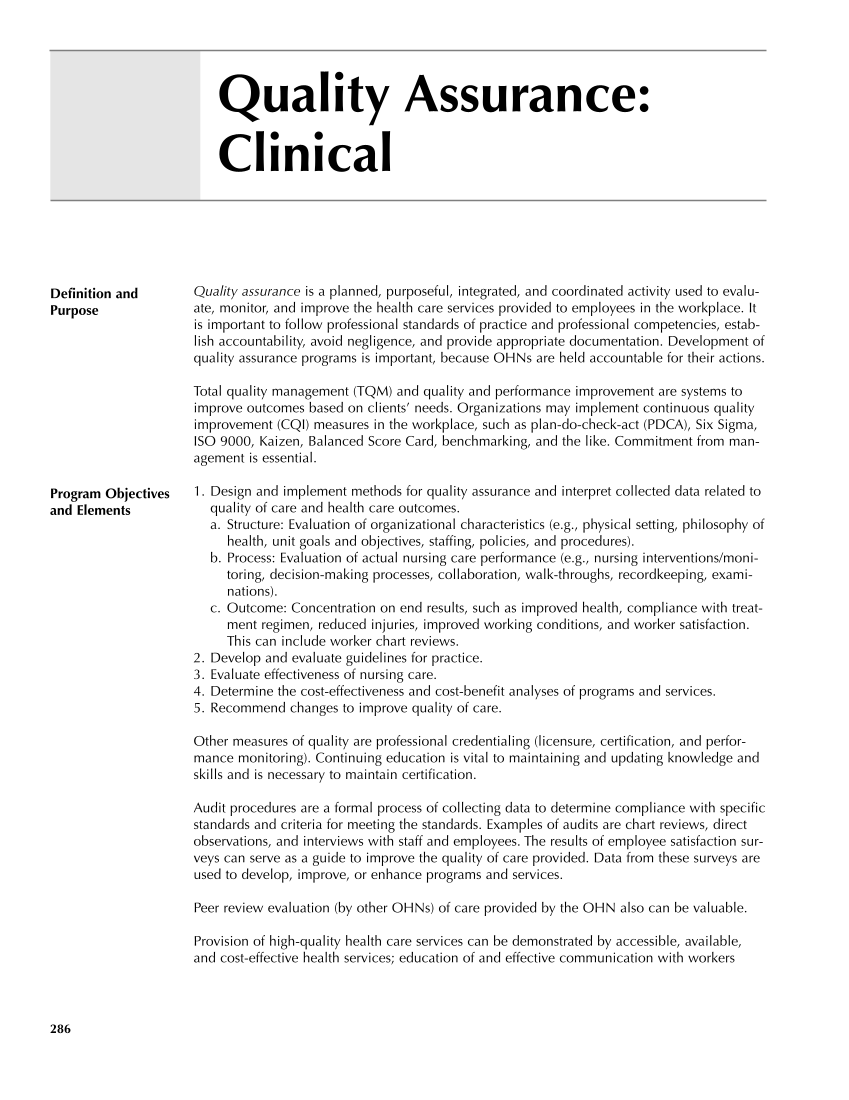286 Quality assurance is a planned, purposeful, integrated, and coordinated activity used to evalu- ate, monitor, and improve the health care services provided to employees in the workplace. It is important to follow professional standards of practice and professional competencies, estab- lish accountability, avoid negligence, and provide appropriate documentation. Development of quality assurance programs is important, because OHNs are held accountable for their actions. Total quality management (TQM) and quality and performance improvement are systems to improve outcomes based on clients’ needs. Organizations may implement continuous quality improvement (CQI) measures in the workplace, such as plan-do-check-act (PDCA), Six Sigma, ISO 9000, Kaizen, Balanced Score Card, benchmarking, and the like. Commitment from man- agement is essential. 1. Design and implement methods for quality assurance and interpret collected data related to quality of care and health care outcomes. a. Structure: Evaluation of organizational characteristics (e.g., physical setting, philosophy of health, unit goals and objectives, staffing, policies, and procedures). b. Process: Evaluation of actual nursing care performance (e.g., nursing interventions/moni- toring, decision-making processes, collaboration, walk-throughs, recordkeeping, exami- nations). c. Outcome: Concentration on end results, such as improved health, compliance with treat- ment regimen, reduced injuries, improved working conditions, and worker satisfaction. This can include worker chart reviews. 2. Develop and evaluate guidelines for practice. 3. Evaluate effectiveness of nursing care. 4. Determine the cost-effectiveness and cost-benefit analyses of programs and services. 5. Recommend changes to improve quality of care. Other measures of quality are professional credentialing (licensure, certification, and perfor- mance monitoring). Continuing education is vital to maintaining and updating knowledge and skills and is necessary to maintain certification. Audit procedures are a formal process of collecting data to determine compliance with specific standards and criteria for meeting the standards. Examples of audits are chart reviews, direct observations, and interviews with staff and employees. The results of employee satisfaction sur- veys can serve as a guide to improve the quality of care provided. Data from these surveys are used to develop, improve, or enhance programs and services. Peer review evaluation (by other OHNs) of care provided by the OHN also can be valuable. Provision of high-quality health care services can be demonstrated by accessible, available, and cost-effective health services education of and effective communication with workers Quality Assurance: Clinical Definition and Purpose Program Objectives and Elements
Purchased from OEM Press by (ge corporate access). (C) 2013 OEM Health Information, Inc. All rights reserved.












































































































































































































































































































































































































































